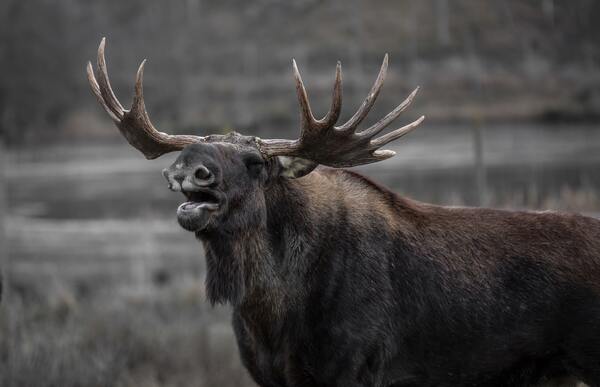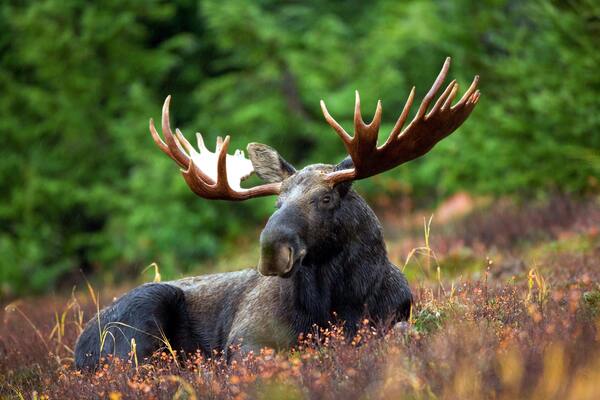Although moose typically don’t attack humans, this doesn’t mean that they can’t be deadly if provoked. Similar to humans, moose get cranky when they’re hungry. If there isn’t any food nearby when they come looking, they’re more likely to lash out at someone. Learn how to avoid being attacked by a moose by reading this article.
Moose
Of all deer species, the moose is the biggest. Males are easily identified by their enormous antlers, which can measure six feet long from end to end. The faces of moose are long, and their muzzles hang over their chins.
Each moose’s throat is covered by a skin flap referred to as a bell. Because they have difficulty lowering their heads to the ground due to their height, moose prefer to browse higher grasses and shrubs.
Signs Of A Moose Attack
What signals a moose is giving you that you should leave them alone? It’s critical to realize that while moose can become aggressive at any time of the year, certain seasons are more likely than others.
For instance, the Washington Department of Fish and Wildlife claims that moose typically become aggressive during the following seasons:
- In late spring, and early summer when a cow (a mother) feels her very young calf is in danger
- In the fall when a breeding bull (a male) is competitive and agitated
- In the winter when they are hungry and tired from walking in deep snow
Additionally, a moose’s body language can indicate whether it will become aggressive. Observe these seven indicators:
- In order to look at you, the moose stops chewing.
- raises the hair on its neck, hump, and hips and tilts back its ears.
- clicks its teeth and licks or smacks its lips.
- walks toward you while lowering its head.
- Urinates.
- reveals its eyes’ whites.
- whips its head back in a horse-like motion.
Each of these signals indicates a potential moose attack. But occasionally, they might not even exhibit any of these symptoms; they might just charge ahead without any prior notice!

What To Do If A Moose Attacks You
Knowing how to respond could save your life in the rare but possible scenario that a moose encounter turns into an attack. There are steps you can take to improve your chances of a better outcome if a moose shows signs of aggression or begins charging at you.
- Back off: The first thing you should do when a moose is approaching you is to move back and hide behind the closest building, tree, or fence that can act as a solid barrier between you and it.
- Run: A bluff charge may be all they are doing when they approach you. They might stop feeling threatened if they see that you’re giving them territory and leave you alone.
- Play dead and curl up like a fetal position: As a last resort, if the moose knocks you to the ground, you should curl up into a ball, place your elbows over your temples in front of you, and lace your fingers behind your neck. Your spine, head, and vital organs will be somewhat protected as a result. Depending on how you react to the moose knocking you to the ground, it may either keep running or begin kicking and stomping you with both front and back hooves. Never try to fight back and keep your focus.
- Don’t get up too soon: Don’t get up until you’re sure the moose have moved far away after it gets tired of kicking and stomping on you. It might attack again, more violently this time, if you stand up while it’s still nearby.
How To Avoid A Moose Attack
It’s crucial to be prepared for moose encounters the next time you’re in the woods now that you are aware of how dangerous they can be. In the northern United States and Canada, moose primarily inhabit forested areas close to ponds, streams, or lakes.
For those who enjoy being outside, these habitats make excellent recreation areas. Therefore, you must be aware of how to stay safe if you happen to come across a moose. There are a number of things you can do to lessen the likelihood of a moose attack.
Give moose plenty of room to start with. Never, under any circumstances, approach one. Every animal has what is referred to as a flight or fight zone that they do not want you to enter.
When you enter that protected area, other deer will probably run away. A moose, on the other hand, might choose to run away or take option number two. Keep your distance if you dare enter its territory because it will charge and stomp you.
I advise leaving your dog at home if you plan to visit an area where moose are present. Keep your dog close by using a leash, though, if you are unable to leave it at home.
All dogs are perceived as predators by moose instinctually. As a result, they will treat your dog in the same way they would a wolf.
Additionally, you are not in a safe location if you unintentionally come in contact with a cow moose and her calf. The best course of action is to back away from a moose calf while causing the least amount of disturbance possible.
A cow moose won’t think twice to run you down and trample you if she sees you as a danger to her calf.
Urban Moose
Never feed moose in a city. Moose that have grown accustomed to being fed by humans pose a threat to all people and put their own lives in danger.
When given less food than they may have wanted, they often become hostile. It will be necessary to relocate or kill this kind of moose. Feeding moose is prohibited in some states, including Alaska.
Moose On The Highway
The Alaska Department of Fish and Wildlife reports that car accidents cause far more moose-related injuries than the animals themselves do. Every year, there are more than 800 collisions involving moose in Alaska.
In some cases, both moose and people die as a result. To avoid hitting a moose, proceed through the area slowly and carefully.
Final Thoughts
Learning about moose attacks and taking precautions before venturing outdoors are the best ways to avoid being attacked by one. Moose attacks on people do happen, though they are uncommon.

